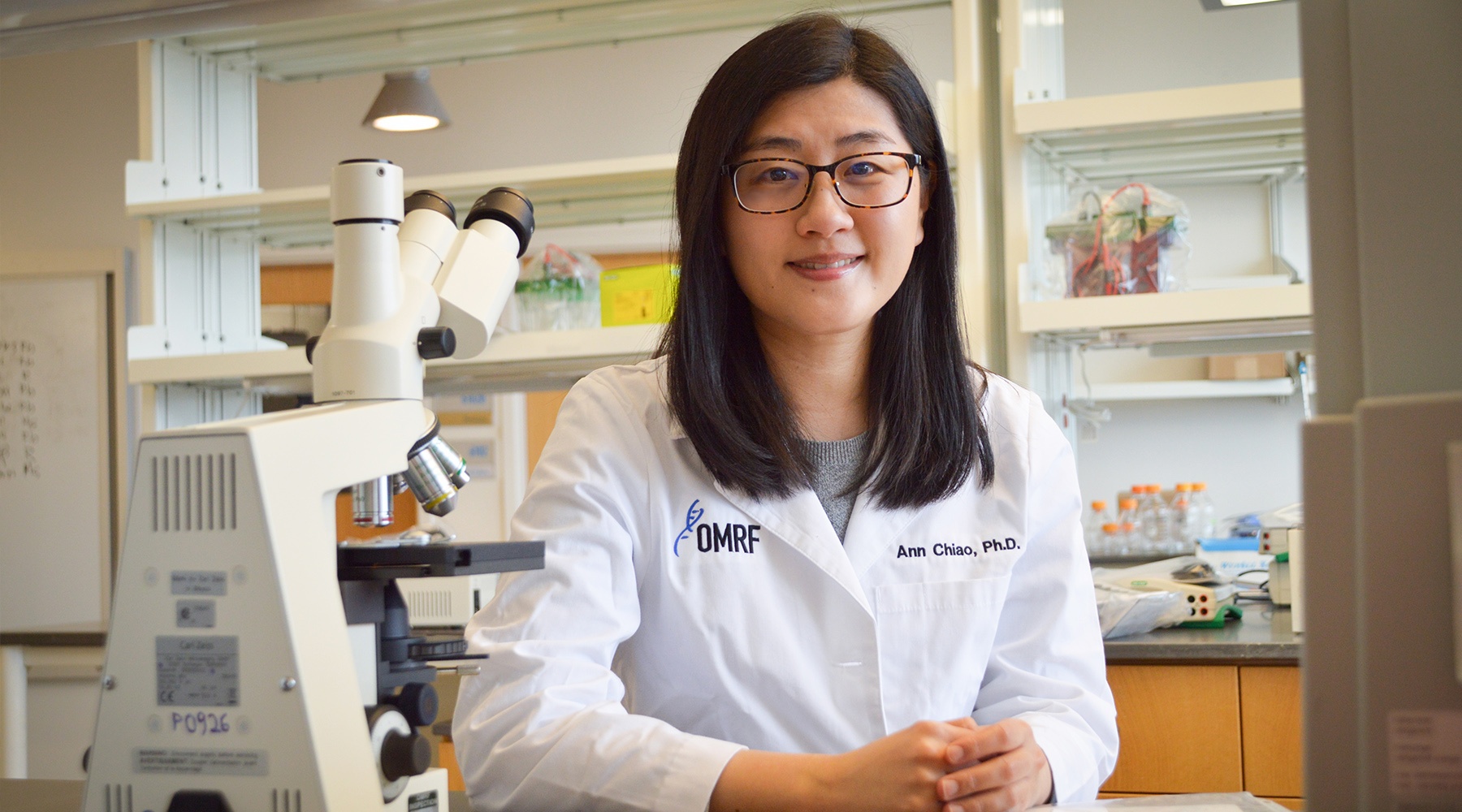Ann Chiao, Ph.D.
Assistant Professor
Aging & Metabolism Research Program
My 101
My lab focuses on studying why heart function declines as we age. Older people have significantly higher rates of cardiovascular disease, including heart attack, stroke, and heart failure, compared to younger individuals. But also, elderly people with no overt cardiovascular disease still exhibit declines in cardiac function, which can lead to exercise intolerance and a cascade of other negative consequences.
Why does this happen? We are using mouse models to study these processes, because the aging mouse heart closely represents what happens in a human heart with age.
We know that cardiac function, both contraction and relaxation of the heart, is impaired with aging. But the deficit in relaxation is more significant than contraction, and we want to investigate the mechanisms behind this age-related impairment in relaxation. When the heart doesn’t relax as it should, it doesn’t completely fill. This reduces cardiac output and ultimately contributes to compromised heart function.
In my lab, we study how cellular and molecular changes during natural aging affect cardiac function, especially cardiac relaxation properties. By understanding the mechanisms of how aging impairs heart function, we can look for potential drugs or interventions targeting these mechanisms to improve cardiac function in the elderly. Our goal is to develop drugs or interventions to delay, lessen or even reverse some of the negative changes in the heart that are caused by natural aging.
Research
Aging exponentially increases the risk of cardiovascular disease and impairs baseline cardiac function, especially diastolic function. Diastolic dysfunction and heart failure with preserved ejection fraction (HFpEF) are both increasing in prevalence in the aged population, contribute to exercise intolerance in the elderly, and are presently without effective treatment. While phenotypes of cardiac aging are well-characterized, the molecular mechanisms of cardiac aging have not been well-established.
My research program focuses on dissecting the molecular mechanisms of cardiac aging and age-related diastolic dysfunction, and developing potential interventions to treat cardiac aging and HFpEF. We use in vivo and in vitro approaches to study the physiological, biochemical and proteomic changes of cardiac aging in mouse models.
We and other have demonstrated that late-life inhibition of mTOR signaling, by caloric restriction (CR) or rapamycin, can reverse cardiac aging phenotypes in mice. Rapamycin treatment inhibits mTOR signaling and induces proteomic and metabolic remodeling in aged hearts. However, how these proteomic and metabolic changes mediate improved diastolic function remain to be established. The research in my laboratory aims to determine the molecular mechanisms of rapamycin-induced reversal of diastolic dysfunction in aged hearts. Specifically, our studies focus on 1) how rapamycin regulates cardiomyocyte relaxation properties in the aging hearts and 2) how rapamycin remodels cardiac extracellular matrix to modify passive myocardial stiffness. In addition, we hope to define the signaling pathways by which rapamycin mediates changes in these key determinants of diastolic function.
The overall goals of the laboratory are to identify novel regulators of cardiac aging and diastolic dysfunction, and to apply this knowledge to the development of therapeutics for cardiac aging and HFpEF.
Brief CV
Education
B.Sc., Chinese University of Hong Kong, 2002
M.Phil., Chinese University of Hong Kong, Molecular Biotechnology, 2006
Ph.D., University of Texas Health Science Center, San Antonio, TX, 2011
Postdoc, University of Washington, Seattle, WA, 2011-2017
Honors and Awards
Young Investigator Award, Thirteen Annual Scientific Meeting of Institute of Cardiovascular Science and Medicine, Hong Kong, 2009
Translational Science Training Scholar, UTHSCSA, 2009
Travel Award, Annual Meeting of the American Society of Biochemistry and Molecular Biology (ASBMB), Experimental Biology Meeting, 2011
Keystone Symposia Scholarship, “Extracellular Matrix and Cardiovascular Remodeling,” 2011
Cardiovascular Section Research Recognition Award, American Physiology Society, 2011
Joe H. Ward, Jr. and Bettie B. Ward Award for Excellence in the Study of the Biology of Aging, Barshop Institute for Longevity and Aging Studies, UTHSCSA, 2011
Paul Horowitz Award for Outstanding Graduate Student, Department of Biochemistry, University of Texas Health Science Center at San Antonio (UTHSCSA), 2011
Young Investigator Award Finalist, Functional Genomic and Translational Biology (FGTB) Council, American Heart Association, 2011
Postdoctoral Fellowship in Aging Research, Ellison Medical Foundation/ AFAR, 2013
NIH/NIA T32 Institutional Postdoctoral Training Grant, 2014
Postdoctoral Fellowship for Translational Research on Aging, Glenn Foundation/ American Federation of Aging Research (AFAR), 2014
Travel Award, American Aging Association Annual Meeting, 2015
Aging Cell Best Paper Prize, “Altered proteome turnover and remodeling by short-term caloric restriction or rapamycin rejuvenate the aging heart”, 2015
K99/R00 Pathway to Independence Award (National Institute on Aging), 2016
Junior Faculty Travel Award, American Aging Association Annual Meeting, 2018
Memberships
American Aging Association
American Heart Association
American Physiology Society
Gerontological Society of America
Joined OMRF scientific staff in 2019
Publications
Recent Publications
Nguyen HVM, Ran Q, Salmon AB, Ahn B, Chiao YA, Bhaskaran S, Richardson A. Mouse Models Used to Test the Role of Reactive Oxygen Species in Aging and Age-Related Chronic Diseases. Free Radic Biol Med, 2024 October, PMID: 39419456, PMCID: PMC11624111
Zarzycka W, Kobak KA, King CJ, Peelor FF 3rd, Miller BF, Chiao YA. Hyperactive mTORC1/4EBP1 signaling dysregulates proteostasis and accelerates cardiac aging. Geroscience, 2024 October, PMID: 39379739
Ramirez-Sagredo A, Sunny AT, Cupp-Sutton KA, Chowdhury T, Zhao Z, Wu S, Chiao YA. Characterizing age-related changes in intact mitochondrial proteoforms in murine hearts using quantitative top-down proteomics. Clin Proteomics 21:57, 2024 September, PMID: 39343872, PMCID: PMC11440756
Selected Publications
Chiao YA, Chakraborty AD, Light CM, Tian R, Sadoshima J, Shi X, Gu H, Lee CF. NAD Redox Imbalance in the Heart Exacerbates Diabetic Cardiomyopathy. Circ Heart Fail:CIRCHEARTFAILURE120008170, 2021 August. PMID: 34374300, PMCID: PMC8373812.
Chiao YA,* Zhang H, Sweetwyne M, Whitson J, Ting YS, Basisty N, Pino L, Quarles E, Thi Nguyen N-H, Campbell MD, Zhang T, Gaffrey MJ, Merrihew G, Wang L, Yue Y, Duan D, Granzier H, Szeto HH, Qian W-J, Marcinek D, MacCoss MJ and Rabinovitch PS.* Late-life restoration of mitochondrial function reverses cardiac dysfunction in old mice. Elife. 2020 Jul 10;9:e55513. (*corresponding authors) PMID: 32648542, PMCID: PMC7377906
Chiao YA, Kolwicz SC, Basisty N, Gagnidze A, Zhang J, Gu H, Djukovic D, Beyer RP, Raftery D, MacCoss MJ, Tian R, Rabinovitch PS. Rapamycin transiently induces mitochondrial remodeling to reprogram energy metabolism in old hearts. Aging (Albany NY). 2016 Feb;8(2):314-27. PMID: 26872208, PMCID: PMC4789585
Karunadharma PP*, Basisty N*, Chiao YA*, Dai D-F, Drake R, Levy N, Koh WJ, Emond MJ, Kruse S, Marcinek D, MacCoss MJ, Rabinovitch PS. Respiratory chain protein turnover rates in mice are highly heterogeneous but strikingly conserved across tissues, ages and treatments. FASEB J. 2015 Aug;29(8):3582-92. *Authors have equal contributions. PMID: 25977255 PMCID: PMC4511201
Dai D-F*, Karunadharma PP*, Chiao YA*, Basisty N*, Crispin D, Hsieh EJ, Chen T, Gu H, Djukovic D, Raftery D, Beyer RP, MacCoss MJ, Rabinovitch PS. Altered proteome turnover and remodeling by short-term caloric restriction or rapamycin rejuvenate the aging heart. Aging Cell. 2014 Jun;13(3):529-39. *Authors have equal contributions PMID: 24612461 PMCID: PMC4040127
Chiao YA, Jin Y, Zamilpa R, Dai Q, Ramirez TA, Zhang J, and Lindsey ML. Matrix Metalloproteinase-9 Deletion Attenuates Myocardial Fibrosis and Diastolic Dysfunction in Ageing Mice. Cardiovasc Res. 2012 Dec 1;96(3):444-55. PMID: 22918978 PMCID: PMC3500048
Contact
Aging & Metabolism Research Program, MS 46
Oklahoma Medical Research Foundation
825 N.E. 13th Street
Oklahoma City, OK 73104
Phone: (405) 271-3116
Fax: (405) 271-1437
E-mail: ann-chiao@omrf.org
For media inquiries, please contact OMRF’s Office of Public Affairs at news@omrf.org.
Lab Staff
Kamil Kobak, Ph.D.
Postdoctoral Scientist
Catherine "Cathy" King
Research Technician IV
Weronika Zarzycka
Graduate Student
Holly Smith
Administrative Assistant III




